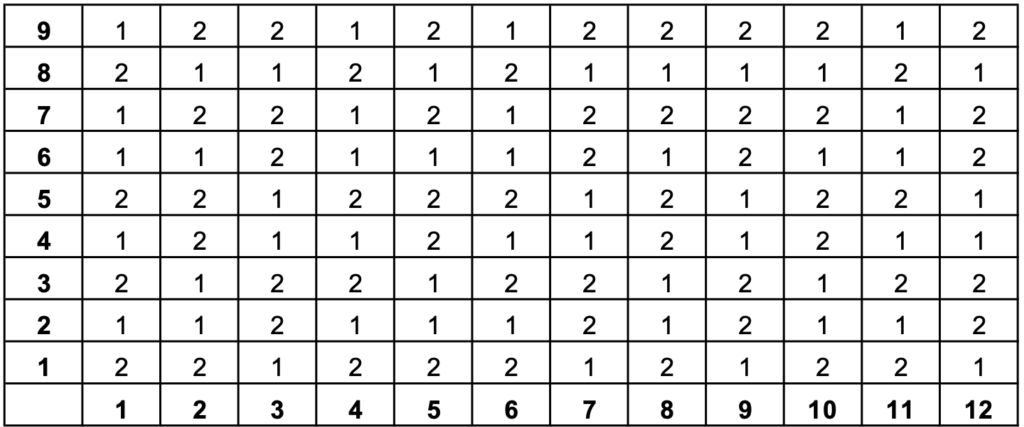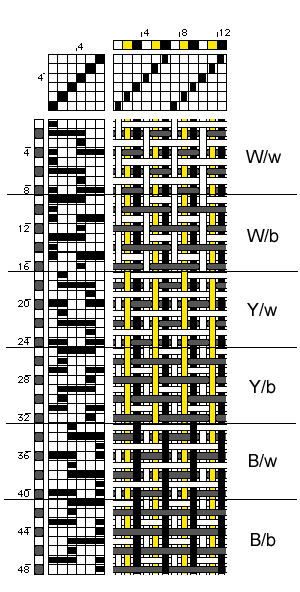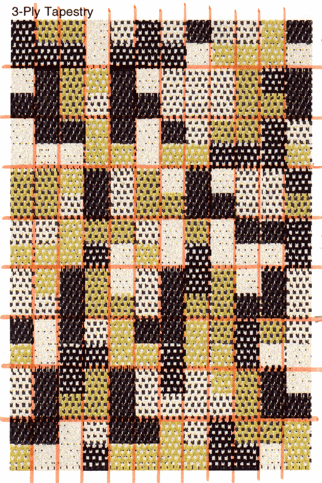In August 1997, I closely examined an Anni Albers wall hanging entitled 3-Ply Tapestry (BR48.138) at the Busch-Reisinger Museum of Harvard University in Cambridge, Massachusetts. A photograph of this hanging appears on page 73 of Bauhaus Textiles: Women Artists and the Weaving Workshop by Sigrid Weltge Wortmann. With the information I gathered, I was able to perform the structural analysis presented here.
The hanging is approximately 4×6 feet. It contains 9 rows and 12 columns of rectangular sections that are either solid or striped. The face yarn combinations of each section are:
|
9
|
B/w
|
Y/b
—- B/w |
Y/b
—- B/w |
W/w
|
W/b
—- B/w |
B/w
|
W/b
—- B/w |
B/b
—- W/w |
W/b
—- Y/w |
W/b
—- Y/w |
Y/w
|
B/b
—- W/w |
|---|---|---|---|---|---|---|---|---|---|---|---|---|
|
8
|
W/w
—- B/b |
B/b
|
Y/b
|
Y/w
—- W/b |
B/b
|
W/w
—- B/b |
W/b
|
W/b
|
W/b
|
Y/b
|
B/w
—- Y/b |
B/b
|
|
7
|
W/w
|
B/b
—- W/w |
B/b
—- W/w |
Y/w
|
B/b
—- Y/w |
W/w
|
B/b
— Y/w |
W/b
—- Y/w |
Y/b
—- B/w |
Y/b
—- B/w |
B/w
|
W/b
—- Y/w |
|
6
|
Y/b
|
Y/b
|
Y/w
—- W/b |
B/b
|
W/b
|
Y/b
|
W/w
—- Y/b |
B/b
|
W/w
—- B/b |
W/b
|
W/b
|
B/w
—- Y/b |
|
5
|
W/b
—- Y/w |
W/b
—- Y/w |
Y/w
|
Y/b
—- B/w |
Y/b
—- W/w |
W/b
—- Y/w |
W/w
|
Y/b
—- B/w |
W/w
|
B/b
—- W/w |
B/b
—- W/w |
B/w
|
|
4
|
W/b
|
Y/w
—- W/b |
B/b
|
Y/b
|
W/w
—- Y/b |
W/b
|
B/b
|
B/w
—- Y/b |
Y/b
|
W/w
—- B/b |
B/b
|
W/b
|
|
3
|
B/b
—- Y/w |
W/w
|
B/b
—- B/w |
W/b
—- B/w |
Y/w
|
B/b
—- Y/w |
B/b
—- B/w |
Y/w
|
Y/b
—- Y/w |
B/w
|
Y/b
—- W/w |
W/b
—- W/w |
|
2
|
W/b
|
B/b
|
B/w
—- Y/b |
Y/b
|
B/b
|
W/b
|
B/w
—- W/b |
W/b
|
Y/w
—- W/b |
Y/b
|
B/b
|
W/w
—- B/b |
|
1
|
B/b
—- Y/w |
B/b
—- W/w |
W/w
|
W/b
—- B/w |
B/b
—- Y/w |
B/b
—- Y/w |
Y/w
|
W/b
—- Y/w |
B/w
|
Y/b
—- B/w |
Y/b
—- W/w |
Y/w
|
|
1
|
2
|
3
|
4
|
5
|
6
|
7
|
8
|
9
|
10
|
11
|
12
|
The warp/weft yarns within each section are coded as:
|
B = black warp yarn
W = white warp yarn Y = yellow warp yarn b = black weft yarn w = white weft yarn |
Striped sections are indicated by giving the order in which the stripes appear within the section. Each striped section contains six repeats of its two alternating stripes.
Ignoring color variations, the structure of each section can be described as either solid (1 color) or striped (2 colors):

Columns 1, 4, 6 and 11 have the same structural sequence: 2, 1, 2, 1, 2, 1, 1, 2, 1.
Columns 2, 5, 8 and 10 have the same structural sequence: 2, 1, 1, 2, 2, 1, 2, 1, 2.
Columns 3, 7, 9 and 12 have the same structural sequence: 1, 2, 2, 1, 1, 2, 2, 1, 2.
When columns within a weaving have the same structure, their warp yarns can be threaded on the same set of shafts, referred to as a block. The face of each column of the hanging shows three different warp colors and is woven in plain weave requiring two shafts. Thus each block requires a separate set of 6 shafts (3 colors multiplied by 2 shafts per color). Because there are three groups of columns sharing the same structural sequence, a loom with at least 20 shafts (3 blocks times 6 shafts per block plus at least 2 shafts for the selvedge) was required in order to weave the piece without hand manipulation.
Only two columns (1 and 6) share the same color and structural sequence. However, the order in which warp colors appear within each column changes in a regular fashion within each column structure. Changing the order in which the warp yarns for a column were threaded would account for the color differences between columns with the same structure. Here is a threading order that might have been used:
|
|
|
Looking only at the face of the hanging, it would be reasonable to assume it was woven as a triple weave. However, an examination of the back of the hanging revealed that it has a double weave structure requiring only two shuttles to weave. Albers achieved this simplicity by having two warp yarns interlace with each weft in the back layer creating a form of basket weave.
This 3-ply double weave pegplan draft shows how to obtain all the color combinations found in the Albers’ 3-ply tapestry hanging when using a W,Y,B threading order.

To test my analysis of the Albers’ hanging, I created a small 3-ply double weave pegplan draft based on the face color combination table and simulated what it would look like woven.
This fabric simulation of the draft was created with PointCarre CAD software at Philadelphia College of Textiles &Science (now Thomas Jefferson University). The hanging was woven slightly warp dominant, so I set up the simulation to be warp dominant as well. The orange grid is marker ink was added to the print out to help clarify the sections.

Comparing my initial pick glass observations against Rosalie Neilson’s1994 analysis on file at the Busch-Reisinger helped me find and correct mistakes in both our observations.
A version of this article appeared in the January 2000 issue of the Complex Weavers Journal.
